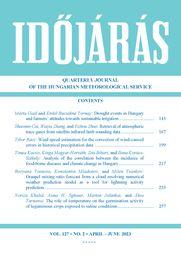IDŐJÁRÁS - angol nyelvű folyóirat
Vol. 127, No. 2 * Pages 143–265 * April - June 2023
 |
|
 letöltés [pdf: 9663 KB]
letöltés [pdf: 9663 KB]
Drought events in Hungary and farmers’ attitudes towards sustainable irrigation
Márta Gaál and Enikő Becsákné Tornay
DOI:10.28974/idojaras.2023.2.1 (pp. 143–165)
Márta Gaál and Enikő Becsákné Tornay
DOI:10.28974/idojaras.2023.2.1 (pp. 143–165)
Retrieval of atmospheric trace gases from satellite infrared limb sounding data
Shaomin Cai, Weijia Zhang,and Yizhou Zhao
DOI:10.28974/idojaras.2023.2.2 (pp. 167–197)
Shaomin Cai, Weijia Zhang,and Yizhou Zhao
DOI:10.28974/idojaras.2023.2.2 (pp. 167–197)
Wind speed estimation for the correction of wind-caused errors in historical precipitation data
Tibor Rácz
DOI:10.28974/idojaras.2023.2.3 (pp. 199–216)
Tibor Rácz
DOI:10.28974/idojaras.2023.2.3 (pp. 199–216)
Analysis of the correlation between the incidence of food-borne diseases and climate change in Hungary
Tímea Kocsis, Kinga Magyar-Horváth, Zita Bihari, and Ilona Kovács-Székely
DOI:10.28974/idojaras.2023.2.4 (pp. 217–231)
Tímea Kocsis, Kinga Magyar-Horváth, Zita Bihari, and Ilona Kovács-Székely
DOI:10.28974/idojaras.2023.2.4 (pp. 217–231)
Graupel mixing ratio forecast from a cloud resolving numerical weather prediction model as a tool for lightning activity prediction
Boryana Tsenova, Konstantin Mladenov, and Milen Tsankov
DOI:10.28974/idojaras.2023.2.5 (pp. 233–251)
Boryana Tsenova, Konstantin Mladenov, and Milen Tsankov
DOI:10.28974/idojaras.2023.2.5 (pp. 233–251)
The role of temperature on the germination activity of leguminous crops exposed to saline conditions
Noriza Khalid, Asma H. Sghaier, Márton Jolánkai, and Ákos Tarnawa
DOI:10.28974/idojaras.2023.2.6 (pp. 253–265)
Noriza Khalid, Asma H. Sghaier, Márton Jolánkai, and Ákos Tarnawa
DOI:10.28974/idojaras.2023.2.6 (pp. 253–265)
IDŐJÁRÁS folyóirat

Az IDŐJÁRÁS a HungaroMet Nonprofit Zrt. negyedévenként megjelenő angol nyelvű folyóirata
Megrendelhető a journal.idojaras@met.hu címen.
A szerzőknek szánt útmutató itt olvasható.
Megrendelhető a journal.idojaras@met.hu címen.
A szerzőknek szánt útmutató itt olvasható.









